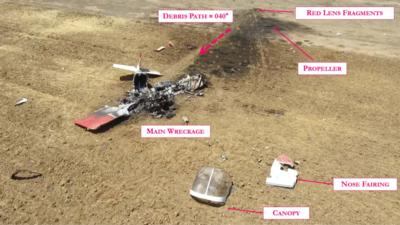Tue, Jul 06, 2021
Footage Revealed That The Airplane Made A Hard Right Bank, With The Wings Near Perpendicular
Location: Porterville, CA Accident Number: WPR21FA223
Date & Time: June 7, 2021, 14:20 Local Registration: N94PJ
Aircraft: Vans RV6 Injuries: 1 Fatal
Flight Conducted Under: Part 91: General aviation - Personal

On June 07, 2021, about 1420, a Vans RV-6A experimental airplane, N94PJ, was substantially damaged when it was involved in an accident in Porterville, California. The pilot was fatally injured. The airplane was operated as a Title 14 Code of Federal Regulations (CFR) Part 91 personal flight. The pilot departed from his home airport in Fresno, California about 1320 and landed at Porterville shortly thereafter.
Numerous witnesses at the airport observed the pilot refuel and takeoff. They stated that the pilot refueled the airplane with about 17.5 gallons at the self-serve fuel tanks located mid-field. A witness observed the pilot, positioned in the right seat, start the airplane after refueling. The start-up was abnormal and sounded as though it was a “hot start” with the airplane rpm’s immediately accelerating to a near maximum setting. The airplane then continued to the departure end of runway 04 and proceeded to takeoff. The airplane began to climb, and the engine was making “popping” sounds while continuing left of centerline. The nose pitched down, and the engine momentarily sounded normal as the airplane then climbed to about 300 ft above ground level (agl). The “popping sounds” continued and some witnesses observed that the engine then experienced a loss of power.
Video footage was obtained from a fixed security camera at the airport. A review of the footage revealed that the airplane made a hard right bank, with the wings near perpendicular to the ground, consistent with the pilot attempting to return to the airport. The witnesses further stated that the airplane then momentarily maneuvered to a wings-level attitude and then rolled left, akin to a snap roll. The airplane then rapidly descended in a left-wing low attitude nearly perpendicular to the terrain and immediately erupted into flames.
The accident site was located about 250 ft from the approach end of runway 12 on flat terrain composed of hard, dry dirt and short vegetation. The wreckage was found distributed over an approximate 40-foot distance with the nose pointed on a median magnetic bearing of about 350°. The fuselage and inboard sections of the wings had been consumed by fire. The first identified piece of debris was fragments of red lens, consistent with the tip of the left wing contacting the ground at the beginning of the accident sequence. From the lens fragments was pieces of propeller blades and pieces of the skin.
More News
Mid-Continent Instruments and Avionics and True Blue Power ANN's NBAA 2025 Coverage... Visit Them At Booth #3436 True Blue Power Introduces New 45-watt Charging Ports for 14- and 2>[...]
En Route Automation System (EAS) The complex integrated environment consisting of situation display systems, surveillance systems and flight data processing, remote devices, decisi>[...]
“Our Kodiak aircraft family is uniquely designed to meet the rigorous demands of such deployments, bringing short takeoff and landing performance, robust cargo capacity and e>[...]
Aero Linx: Australian Society of Air Safety Investigators (ASASI) The Australian Society of Air Safety Investigators (ASASI) was formed in 1978 after an inaugural meeting held in M>[...]
Left Main Landing Gear Struck A Bush, And The Right Wingtip Impacted The Ground Analysis: According to the pilot of the tailwheel-equipped airplane, he noticed that the engine oil >[...]
 True Blue Power and Mid-Continent Instruments and Avionics Power NBAA25 Coverage
True Blue Power and Mid-Continent Instruments and Avionics Power NBAA25 Coverage ANN's Daily Aero-Term (10.15.25): En Route Automation System (EAS)
ANN's Daily Aero-Term (10.15.25): En Route Automation System (EAS) Aero-News: Quote of the Day (10.15.25)
Aero-News: Quote of the Day (10.15.25) ANN's Daily Aero-Linx (10.15.25)
ANN's Daily Aero-Linx (10.15.25) NTSB Final Report: Jeremy S Lezin Just SuperSTOL
NTSB Final Report: Jeremy S Lezin Just SuperSTOL



